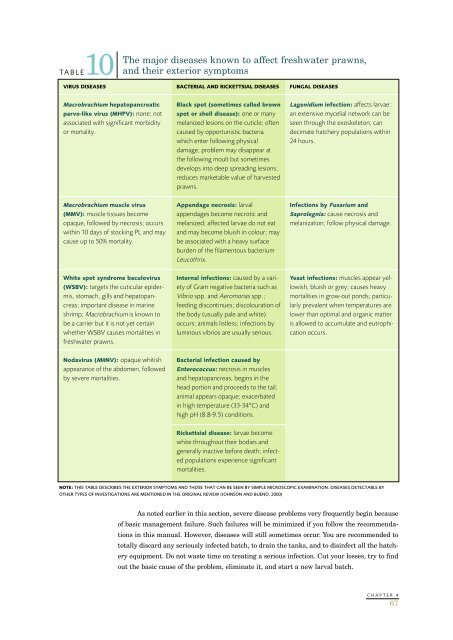Create successful ePaper yourself
Turn your PDF publications into a flip-book with our unique Google optimized e-Paper software.
TABLE10The major diseases known to affect <strong>freshwater</strong> <strong>prawns</strong>,and their exterior symptomsVIRUS DISEASESBACTERIAL AND RICKETTSIAL DISEASESFUNGAL DISEASESMacrobrachium hepatopancreaticparvo-like virus (MHPV): none; notassociated with significant morbidityor mortality.Black spot (sometimes called brownspot or shell disease): one or manymelanized lesions on the cuticle; oftencaused by opportunistic bacteriawhich enter following physicaldamage; problem may disappear atthe following moult but sometimesdevelops into deep spreading lesions;reduces marketable value of harvested<strong>prawns</strong>.Lagenidium infection: affects larvae:an extensive mycelial network can beseen through the exoskeleton; candecimate hatchery populations within24 hours.Macrobrachium muscle virus(MMV): muscle tissues becomeopaque, followed by necrosis; occurswithin 10 days of stocking PL and maycause up to 50% mortality.Appendage necrosis: larvalappendages become necrotic andmelanized; affected larvae do not eatand may become bluish in colour; maybe associated with a heavy surfaceburden of the filamentous bacteriumLeucothrix.Infections by Fusarium andSaprolegnia: cause necrosis andmelanization; follow physical damage.White spot syndrome baculovirus(WSBV): targets the cuticular epidermis,stomach, gills and hepatopancreas;important disease in marineshrimp; Macrobrachium is known tobe a carrier but it is not yet certainwhether WSBV causes mortalities in<strong>freshwater</strong> <strong>prawns</strong>.Internal infections: caused by a varietyof Gram negative bacteria such asVibrio spp. and Aeromonas spp.;feeding discontinues; discolouration ofthe body (usually pale and white)occurs; animals listless; infections byluminous vibrios are usually serious.Yeast infections: muscles appear yellowish,bluish or grey; causes heavymortalities in grow-out ponds; particularlyprevalent when temperatures arelower than optimal and organic matteris allowed to accumulate and eutrophicationoccurs.Nodavirus (MRNV): opaque whitishappearance of the abdomen, followedby severe mortalities.Bacterial infection caused byEnterococcus: necrosis in musclesand hepatopancreas; begins in thehead portion and proceeds to the tail;animal appears opaque; exacerbatedin high temperature (33-34°C) andhigh pH (8.8-9.5) conditions.Rickettsial disease: larvae becomewhite throughout their bodies andgenerally inactive before death; infectedpopulations experience significantmortalities.NOTE: THIS TABLE DESCRIBES THE EXTERIOR SYMPTOMS AND THOSE THAT CAN BE SEEN BY SIMPLE MICROSCOPIC EXAMINATION. DISEASES DETECTABLE BYOTHER TYPES OF INVESTIGATIONS ARE MENTIONED IN THE ORIGINAL REVIEW (JOHNSON AND BUENO, 2000)As noted earlier in this section, severe disease problems very frequently begin becauseof basic management failure. Such failures will be minimized if you follow the recommendationsin this manual. However, diseases will still sometimes occur. You are recommended tototally discard any seriously infected batch, to drain the tanks, and to disinfect all the hatcheryequipment. Do not waste time on treating a serious infection. Cut your losses, try to findout the basic cause of the problem, eliminate it, and start a new larval batch.CHAPTER 467
















